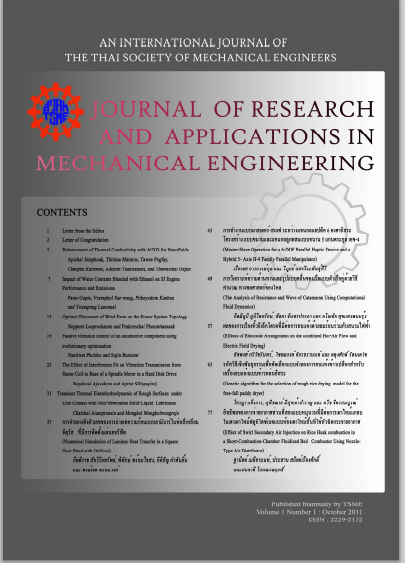Effect of tube length on combustion characteristics of a Self-aspirating Radiant Tube Burner (SRTB)
Main Article Content
Abstract
Radiant tube burners (RTBs) are widely used in heating process of industrial production such as batch annealing and heat treating process. Most of the RTBs operate at high capacity that use a lot of fuel and combustion air to yield high gas temperature. Therefore, the air compressor is needed in order to supply the sufficient air for completely combustion. The objective of this research is to study the effect of the tube length on combustion characteristics of a self-aspirating radiant tube burner (SRTB) equipped with an energy recirculation using a porous heat exchanger concept. Three different lengths of Ushaped tube of 10 cm in diameter were selected, i.e. 0.8 m, 1.0 m and 1.25 m, respectively, which are called as tube S, M and L in the study. Because the combustion air is naturally entrained through the venturi burner by the momentum of fuel jet, therefore the air compressor is not used in this method. Temperature distribution along the SRTB and emission (NOx & CO) were measured. The results show that the temperature distribution of the tube L is higher than the other tubes at the same firing rate (FR). The flame can stabilize inside the SRTB for the FR in the range of 3.66-8.28 kW. The maximum temperature inside SRTB is 1,481oC. The NOx and CO emission are less than 336 ppm and 450 ppm, respectively.
Article Details
This work is licensed under a Creative Commons Attribution-NonCommercial-ShareAlike 4.0 International License.
References
[2] Katsuki, M. and Hasegawa, T. (1998). The science and technology of combustion in highly preheated air, in: 27th Symposium (International) on Combustion/ The Combustion
Institute, pp. 3135–3146.
[3] Echigo, R. (1982). Effective energy conversion method between enthalpy and thermal radiation and application to industrial furnace, Proceedings of the 7th Heat Transfer
Conference, Munich, 6, pp. 361–366.
[4] Jugjai, S. and Rungsimuntuchart, N. (2002). High efficiency heat-recirculating domestic gas burners, Experimental Thermal and Fluid Science; 26(5), pp. 581–592.
[5] Scribano, G., Solero, G., and Coghe, A. (2006). Pollutant emissions reduction and performance optimization of an industrial radiant tube burner, Experimental Thermal and
Fluid Science; 30, pp. 605–612.
[6] Chuenchit, C. and Jugjai, S. (2011). Self - aspirating radiant tube burner, paper present in the 4th International Conference on Sustainable Energy and Environment (SEE 2011), Bangkok, Thailand.
[7] Namkhat, A. and Jugjai, S. (2010). Primary air entrainment characteristics for a self-aspirating burner: model and experiments, Energy, 35(4), pp. 1701-1708.
[8] Sullivan, J.D. and Kendall, R.M. (1992). Thermal performance and NOx emissions from porous surface radiant burners, International Gas Research conference, pp.1626-1634



